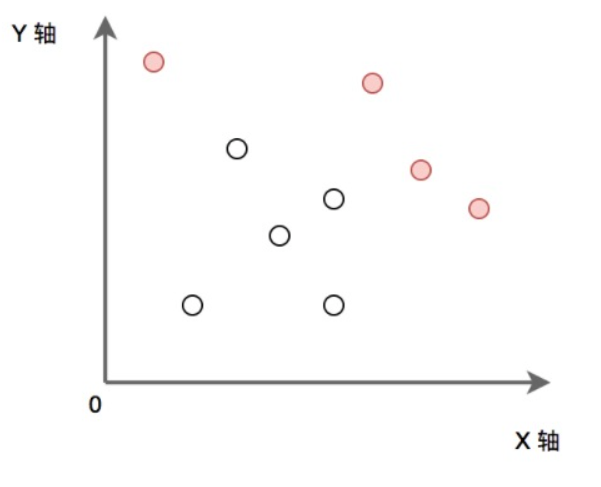第一题:
P为给定的二维平面整数点集。定义 P 中某点x,如果x满足 P 中任意点都不在 x 的右上方区域内(横纵坐标都大于x),则称其为“最大的”。求出所有“最大的”点的集合。(所有点的横坐标和纵坐标都不重复, 坐标轴范围在[0, 1e9) 内)
如下图:实心点为满足条件的点的集合。请实现代码找到集合 P 中的所有 ”最大“ 点的集合并输出。

题解:
要找到所有“最大”的点,要求是右上方无其他点。
考虑从最大x坐标往左搜索,此时第一个点肯定是最右边的且此时其上方也无其他点。后面每循环到的点,右边是已循环过的点,此时需判断当前点的y坐标是否高于已循环过的最大y坐标,若大于则是“最大”点。
#内存超限,写法不简短 n = int(input()) class point(): def __int__(self): self.x, self.y = -1, -1 def toS(self): return self.x,self.y p_list = [] for i in range(n): t = input() p = point() tx, ty = t.split(' ') p.x, p.y = int(tx), int(ty) p_list.append(p) p_list = sorted(p_list, key=lambda point: point.x, reverse=True) now = -1 ep = [] for i in range(n): if p_list[i].y > now: p = point() p.x, p.y = p_list[i].x, p_list[i].y now = p_list[i].y ep.append(p) ep = sorted(ep, key=lambda point: point.x) for p in ep: print(str(p.x) + ' ' + str(p.y))
#内存超限,从y轴开始搜索,比较x值;写法简便 n = int(input()) p_list = [] for _ in range(n): x, y = [int(x) for x in input().split()] p_list.append((x,y)) p_list = sorted(p_list, key=lambda x: x[1], reverse=True) max_x = float('-inf') for x, y in p_list: if x > max_x: print(x, y) max_x = x
//AC代码 #include<iostream> #include<algorithm> using namespace std; const int maxn = 500010; struct point { int x, y; }st[maxn],ed[maxn]; bool cmp(point a, point b) { return a.x > b.x; } int main(){ int n; cin >> n; for( int i = 0; i < n; i ++ ) { cin >> st[i].x >> st[i].y; } sort(st,st+n,cmp); int now = -1, cnt = 0; for( int i = 0; i < n; i ++ ) { if( now < st[i].y ) { now = st[i].y; ed[cnt].x = st[i].x, ed[cnt].y = st[i].y; cnt ++; } } sort(ed,ed+n,cmp); for( int i = cnt-1; i >= 0; i -- ) { cout << ed[i].x << " " << ed[i].y << endl; } return 0; }
第二题:
给定一个数组序列, 需要求选出一个区间, 使得该区间是所有区间中经过如下计算的值最大的一个:
区间中的最小数 * 区间所有数的和最后程序输出经过计算后的最大值即可,不需要输出具体的区间。如给定序列 [6 2 1]则根据上述公式, 可得到所有可以选定各个区间的计算值:
[6] = 6 * 6 = 36;
[2] = 2 * 2 = 4;
[1] = 1 * 1 = 1;
[6,2] = 2 * 8 = 16;
[2,1] = 1 * 3 = 3;
[6, 2, 1] = 1 * 9 = 9;
从上述计算可见选定区间 [6] ,计算值为 36, 则程序输出为 36。
区间内的所有数字都在[0, 100]的范围内;
题解:
求区间最大值。最大值为最小值乘以区间和。
考虑确定最小值的时候,区间和越大则区间最大值越大。所以求区间最大值可以转变为找区间最小值。
遍历区间找到最小值,然后比较此时最小值确定时的最大值、最小值左边区间最大值、最小值右边区间最大值三者的大小。
搜索左边、右边至单个元素被搜索到,比较所有值确定最大值。
//AC代码,算了一下我认为计算可能超int,便使用了long long #include<iostream> #include<algorithm> using namespace std; int maxn = 500010; long long findn( int left, int right, long long a[] ) { if( left >= right ) { return 0; } int minn = 101, mid; long long sum = 0; for( int i = left; i < right; i ++ ) { if( minn > a[i] ) { minn = a[i]; mid = i; } sum += a[i]; } return max(sum*minn,max(findn(left,mid,a),findn(mid+1,right,a))); } int main(){ long long n, a[maxn]; cin >> n; for( int i = 0; i < n; i ++ ) { cin >> a[i]; } cout << findn(0,n,a) << endl; return 0; }
第三题
产品经理(PM)有很多好的idea,而这些idea需要程序员实现。现在有N个PM,在某个时间会想出一个 idea,每个 idea 有提出时间、所需时间和优先等级。对于一个PM来说,最想实现的idea首先考虑优先等级高的,相同的情况下优先所需时间最小的,还相同的情况下选择最早想出的,没有 PM 会在同一时刻提出两个 idea。
同时有M个程序员,每个程序员空闲的时候就会查看每个PM尚未执行并且最想完成的一个idea,然后从中挑选出所需时间最小的一个idea独立实现,如果所需时间相同则选择PM序号最小的。直到完成了idea才会重复上述操作。如果有多个同时处于空闲状态的程序员,那么他们会依次进行查看idea的操作。
求每个idea实现的时间。
输入第一行三个数N、M、P,分别表示有N个PM,M个程序员,P个idea。随后有P行,每行有4个数字,分别是PM序号、提出时间、优先等级和所需时间。输出P行,分别表示每个idea实现的时间点。
题解:
PM的最想完成idea是优先级最大的idea,优先级相同时时所需时间最小的。每个程序员空闲时是从所有PM最想完成的idea中挑选所需时间最小的完成,时间相同选择PM序号最小。
考虑使用一个优先级队列数组,存每个PM想完成的idea,按题目规则排序。再使用一个优先级队列存每个程序员已花费时间。
注意:存在的特殊情况是程序员空闲但时间未到PM任务的开始时间。此时增加优先级队列中程序员的时间。
参考:https://www.kanzhun.com/jiaocheng/584615.html
//AC代码 #include<queue> #include<vector> #include<cstdio> #include<iostream> #include<algorithm> using namespace std; const int maxn = 3010; struct node { int pm, st, prior, cost, index; }; struct cmpStruct { bool operator()( node a, node b ) { if( a.prior != b.prior ) { return a.prior < b.prior; } else if( a.cost != b.cost ) { return a.cost > b.cost; } else if( a.st != b.st ) { return a.st > b.st; } return a.pm > b.pm; } }; bool cmp( node a, node b ) { return a.st < b.st; } int main() { int ans[maxn]; node no[maxn]; vector<node> vec[maxn]; priority_queue<node, vector<node>, cmpStruct> q[maxn]; priority_queue<int, vector<int>, greater<int> > q_time; int n, m, p; cin >> n >> m >> p; for( int i = 0; i < p; i ++ ) { cin >> no[i].pm >> no[i].st >> no[i].prior >> no[i].cost; no[i].index = i+1; } sort(no,no+p,cmp); int task_start_id = 0; for( int i = 0; i < m; i ++ ) { q_time.push(1); } int start_time = q_time.top(); int task_finish_cnt = 0; while( 1 ) { int i = task_start_id; for( ; i < p; i ++ ) { if( no[i].st <= start_time ) { q[no[i].pm].push(no[i]); } else { break; } } task_start_id = i; q_time.pop(); int minn = maxn, pm_id = 0; for( int i = 1; i <= n; i ++ ) { if( !q[i].empty() && q[i].top().cost < minn ) { minn = q[i].top().cost; pm_id = i; } } if( pm_id > 0 ) { int finish_time = start_time + q[pm_id].top().cost; ans[q[pm_id].top().index] = finish_time; task_finish_cnt ++; if( task_finish_cnt == p ) { break; } q_time.push(finish_time); q[pm_id].pop(); } else { q_time.push(start_time+1); } start_time = q_time.top(); } for( int i = 1; i <= p; i ++ ) { cout << ans[i] << endl; } return 0; }
第四题
给定一棵树的根节点, 在已知该树最大深度的情况下, 求节点数最多的那一层并返回具体的层数。
如果最后答案有多层, 输出最浅的那一层,树的深度不会超过100000。实现代码如下,请指出代码中的多处错误:
参考:https://blog.csdn.net/f_zyj/article/details/79162401
struct Node { vector<Node*> sons; }; void dfsFind(Node *node, int dep, int counter[]) { counter[dep]++; for(int i = 0; i < node.sons.size(); i++) { dfsFind(node.sons[i], dep, counter); } } int find(Node *root, int maxDep) { int depCounter[100000]; dfsFind(root, 0, depCounter); int max, maxDep; for (int i = 1; i <= maxDep; i++) { if (depCounter[i] > max) { max = depCounter[i]; maxDep = i; } } return maxDep; }
/* * Node 结构体,包含一个元素为 Node * 的向量 * 用来存储树结构的父子关系 */ struct Node { vector<Node*> sons; }; /* * 深度优先遍历,用来遍历树并且对每层结点数计数 * node 为父节点的指针,dep 为深度,counter 为存储每层结点数的数组 */ void dfsFind(Node *node, int dep, int counter[]) { counter[dep]++; // 计数操作 for(int i = 0; i < node->sons.size(); i++) { // 错误 1 指针操作错误 dfsFind(node->sons[i], dep + 1, counter); // 错误 2 指针操作错误,深度控制不当 } } /* * find 函数,root 是树的根,maxDep 是树的最大深度 */ int find(Node *root, int maxDep) { int depCounter[100003]; // 错误 3 存储树的每层结点数.可能存在越界问题 dfsFind(root, 0, depCounter); // 调用深度优先遍历函数, // 传入根和初始深度以及存储数每层结点数的数组 int max = 1, res = 0; // 错误 4 未初始化、命名冲突 for (int i = 1; i <= maxDep; i++) { if (depCounter[i] > max) { max = depCounter[i]; res = i; // 错误 5 被赋值变量错误 } } return res; // 错误 6 返回错误变量 }
第五题
设计:
1、长链转短链
发号器,每过来一个长链换短链请求发一个号,发号器所发号码从 0 自增,所发号码为十进制,转化为 62进制后作为短链(62 进制对应 26 小写字母加上 26大写字母还有 10 数字)。
2、短链跳转长链
将短链所对应号码与长链一一映射存储于表中。
优化:
1、长链对应唯一短链
当长链转短链请求过来时率先在字典树(映射)中查找该长链是否已经分配短链,如果分配,则直接返回短链,若未分配则利用发号器继续分配。字典树在发号同时建立。
2、系统架构与高并发
采用 key−value 分布式储存系统,创建更多发号器,减小发号请求高并发时的压力,比方说创建 10000 个发号器,1发号器发号从 0∼9999,2发号器发号从10000~19999依次类推,每个发号器对应一片内存存储所发号码与长链对应的表,减小跳转访问高并发时的压力。
3、存储和缓存
利用分布式系统,采用 NoSql 数据库存储彼此一一映射,采用 LRU算法管理内存与缓存。
参考:https://blog.csdn.net/f_zyj/article/details/79162401
附上:短网址系统如何实现?